Jungle Aquariums
Now that you already determined the ideal location and dimensions of your tank, it is time to think about your planted aquarium style. This article will discuss the different aquascaping designs to unleash the inner artist in you, specifically the Jungle Aquariums.
Aquascaping is the art of arranging aquatic plants, driftwood, rocks, stones, and even the substrate in an aesthetically pleasing and natural manner.
You probably searched on the internet and was overwhelmed by tons of aquascaping images and still cannot decide. So in this article: the main characteristics, what tank to use, light, substrate, if you need CO2, what filter, fertilizer, hardscape, what fish and plants will be discussed to help you in your decisions.
Table of Contents
Jungle Style
What Tank to Use?
What Light to Use?
What Substrate?
Do I Need to Inject CO2?
Filtration
Do I Need to Dose Fertilizers?
Hardscape
What Fish?
Plants Selection
Conclusion
Closing Remarks
Why is it so important to know the different aquascaping designs?
These are no strict rules, and there is nothing that will hinder you from getting out of a particular design’s theme and combine it with other styles.
However, you’ll probably can create a much more appealing result if you are following a particular style.
So without further ado, here are the most common styles/designs you’ll see in planted aquariums.
Jungle Style
Many of the hobbyists worldwide refer to the Jungle Style separate from either Nature or Dutch styles of aquascaping. We can even consider the Jungle style a sub-type of the Nature style.
The only difference is the wild, untamed (no trimming here, well, you can if you choose to do so) look. It is the complete opposite of the Dutch style, more organized and looks like a conventional tulips garden.
Jungle Style Aquascaped by Alain Denco Invierno
The Jungle style overlaps with the core elements of the Nature Style except that the Jungle Style has little to no visible hardscape and limited open space due to the overgrown plants. The plants are even allowed to reach the surface and beyond.
It is quite popular in larger tanks, where the full-scale of the design can be effectively conveyed. The goal is self-explanatory, and that is to emulate a jungle.
The style requires less frequent maintenance in general and employs mostly undemanding/hardier plants to lighting, nutrients, and CO2.
Bold, courser leaf-type plants are used in this style, such as Echinodorus species, Cryptocoryne species (crypts), Jungle Vallisneria, Vallisneria Sagittaria, Corkscrew Val, and even tuber-type plants like Nymphaea species. Overgrown leaves can naturally block the light, or you can use floating plants as well.
The combinations of a dark substrate such as aqua soil or regular organic potting/gardening soil topped with inert black sand and tall plants growing up to the surface will create a natural jungle canopy to your aquascape.
Before – Jungle Style Aquascaped by Fritz Rabaya Philippines
After – Jungle Style Aquascaped by Fritz Rabaya Philippines
Unlike the Nature style, there are no small details here. The Jungle Style does not follow fine lines and textures. There are even no focal points as the plants will hide the hardscape (if there is any). The core elements of a Jungle style is to depict a chaotic, unbounded, and wild ecosystem.
It is a style very close to Nature. Nature does not have trimming scissors. She does this naturally. When a plant’s leaf gets old and deteriorates, it detaches from the mother plant and falls in the soil or washed away by the current in submerged ecosystems. It can then serve as fertilizer for the mother plant itself and other plants nearby.
Jungle Style 2.5 Gallon Nano Tank Aquascaped by Marcky Bevic Rivera Philippines
What Tank to Use?
Since you are using large-growing plants, larger tanks are the main game here. From 30 gallons and up, we can effectively portray the scale of the large plants used. But there is no stopping you from using tanks below 30 gallons (like the scape below using a 2.5-gallon tank). Just use hardscapes, plants, and fishes that are proportionally correct with your tank size.
What Light to Use?
The jungle canopy effect – combinations of a dark substrate such as aquasoil or organic potting soil topped with inert black sand and tall plants growing up to the surface will block the light shining through and create a mottled lighting effect.
Colors of the plants are limited, and it is not ideal to use higher light intensity demanding plants (colored plants). A decent LED lighting for planted aquariums or T5 array can do the job well.
I will still recommend using a dimmer in your lighting whenever you can so you can adjust the intensity of your light lower when you notice algae starting to show up. The only ways you can adjust the intensity of a T5 array are by subtracting or adding tubes or adjusting the height higher or lower.
Besides, plant selection is of the undemanding types, which I mentioned above, so there is no need to get picky with your lighting fixture.
If you know electronics and building skills, you can even DIY/experiment with your light fixture with LED bulbs, high powered LED beads. Some had success with LED floodlights, even 5730, 5630, 5050, and 3528 LED strips. I personally DIYed a 5630 LED strips lighting fixture, with warm white, cool white, red and blue LEDs, and with just a generic 3rd party dimmer.
Whichever route you choose for your planted aquarium lighting, the most important thing is you should be able to control/adjust the intensity (which can be done with 3rd party dimmers for LEDs, or if dimmers are not possible, you should be able to adjust the height of your lighting fixture.
For a more in-depth discussion about planted aquarium lighting, go here.
Jungle Style Aquascaped by Stoffer Samudio Philippines
What Substrate?
Aquasoil can provide the nutrients for the root-feeders such as the Echinodorus and Cryptocoryne species, which can quietly grow large if given a chance. You can also use organic potting/gardening soil top with a thin layer of inert black sand.
Here in the Philippines, some hobbyists even cook/fry the regular garden soil or cook the soil under the sun for several days before using it. This is to ensure that there are no worms, parasites, or eggs that can hitchhike in our planted aquariums.
Be mindful, though, of using Echinodorus species (Amazon Swords). Their root systems will eventually span the whole tank under your substrate once they are established. So don’t even try to uproot them. It will be a mess and can even damage your scape and uproot other plants as well, not to mention the gunk and debris that will be disturbed by uprooting.
Jungle Style Aquascaped by Franco Chester Pongco Philippines
My Overgrown Look Tank – No Time to Trim – Aquascaped by Lemuel Sacop Philippines
Do I Need to Inject CO2?
As recommended above, with undemanding plants and jungle-like canopy, no high-lighting, there is no need to use CO2 injection here. However, it will take time for the plants to outgrow your tank and achieve the desired effect.
I experimented with low to medium lighting plus CO2 injection, plus low-light plants (undemanding), and the results are rewarding. We will cover these in-depth under the CO2 Injection article soon.
Filtration
For large tanks, we will recommend an appropriately sized canister filter. The filter of your choosing, aside from the filtration, should provide the water surface agitation, distribution of the nutrients, and dissolved CO2 enriched water across the whole tank.
You can also deploy mini submersible pumps to aid with the water circulation. Plants swaying with the gentle flow of the water is a sight to behold.
Aim for x5 to x10 water turn-over rate. For example, if you have a 50 gallons tank, you should choose a filter that turns over the water at the rate of 250 gallons per hour (gph x5) to 500 gallons per hour (gph x10).
The different types of filtration, types of filters that we can use in our planted aquariums, and considerations of what to look for in a planted aquarium filter are all discussed here.
Jungle Style 200 Gallons High-Tech Aquascaped by Michael Yap Philippines
If your tank is huge and no filter can give you the turn-over rate of x5 to x10 gph, we recommend using two HOBs or two canister filters. You can also use a carefully designed Sump Filter, but we will not recommend this type of filter for a beginner for now.
Do I Need to Dose Fertilizers?
Dosing fertilizers are needed to be able to achieve the overgrown look of a Jungle Style faster. The combination of nutrient-rich substrate, undemanding plants, along with regular water column dosing, no high-light, with CO2 injection, will achieve the Jungle canopy faster.
Jungle Style Aquascaped by Alain Denco Invierno
But if you are not in a hurry, dosing leaner is fine or even not at all, along with subdued lighting and no CO2 injection.
You can insert Osmocote capsules/beads (a slow-release fertilizer) deep into the substrate to fertilize the substrate. Most carpeting plants benefit from this to spread faster and get thicker. This also works on your hungry stem plants by inserting beads of Osmocote near the plants’ roots.
Even aqua soils deplete their nutrients over time, and you can insert Osmocote into your substrate every 6 months.
Hardscape
We can use rocks and driftwood in a jungle style aquascape. Just remember that the plant life may cover them. One tip I can give you is to plant the tall-growing plants at the back and put your hardscape off-center of the tank. Another suggestion is to use a large piece of driftwood, even protruding/hanging outside the tank or water surface.
One large piece of driftwood, though, is costly in the market. You can hunt for driftwood appropriate to your tank size if you are near mountains and forests, lakes, swamps, or rivers. Just remember to clean and treat them first to avoid hitch-hikers.
What Fish?
Due to the scale you are trying to portray and the large tanks involved, we recommend Rainbow Fish, Discus, and Angels but not the largest-of-them all monster fishes.
Arowanas and Pacus, for example, are strong swimmers. One swipe of their muscular tails can damage your hardscape and plants, and can even take damage themselves. They also need a lot of open space for swimming, which a Jungle style cannot give unless you have a massive tank (200 gallons and up).
You can still use nano fishes like Neon/Cardinal Tetras along with Discus and Angels to add fauna life diversity.
You can also add invertebrates such as snails and shrimps to the nano fish species mentioned above. Some hobbyists only keep snails and shrimps with no fish at all. For snails, we recommend Nerite and Ramshorn Snails. For Ramshorn snails, though, be mindful that their reproduction rate is proportional to the amount of food inside the aquarium (so don’t overfeed). Freshwater snails feast on organic matter (dead plant leaves, even dead fish, etc.), uneaten fish food, some types of algae. They can even clean your glass but not really efficient.
As for shrimps, we recommend Amano Shrimps, Red Cherry Shrimps (RCS), and other color morphs (Neocaridina sp.) and Caridina sp. (though more sensitive to your water parameters than Neocaridinas). Do not keep shrimps, though, if you have medium to large omnivorous fish. Always follow this rule: If you think the shrimp fits in their mouth, they will probably get eaten eventually.
Conclusion:
The Jungle style is a unique, natural, and untamed style of aquascaping.
The combination of less frequent maintenance, low-light plants, low-medium lighting, less fertilization, and no CO2 injection will certainly appeal to most hobbyists.
Want to Explore More?
Closing Remarks
I hope you enjoyed this article and if ever you have additional questions or want to share your experiences with the Jungle Style Aquariums, please leave a comment below.
Next, we will be discussing the Hardscape Diorama Style.


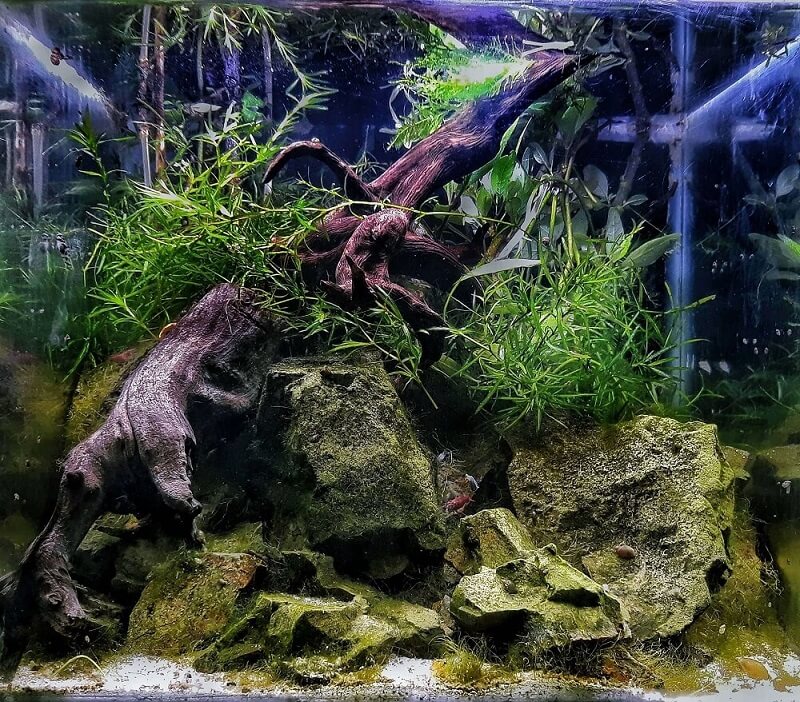

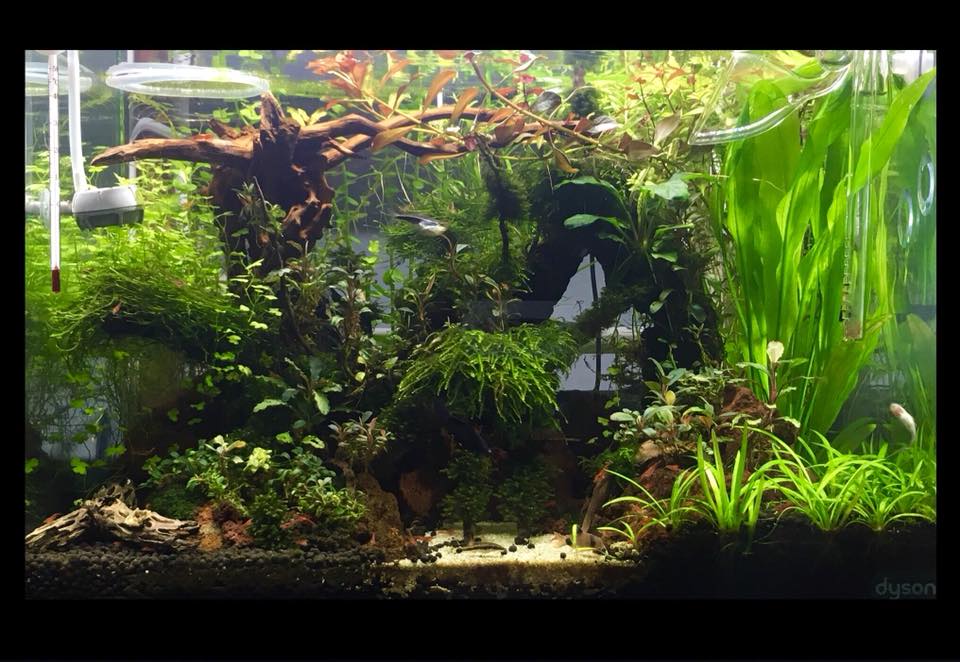







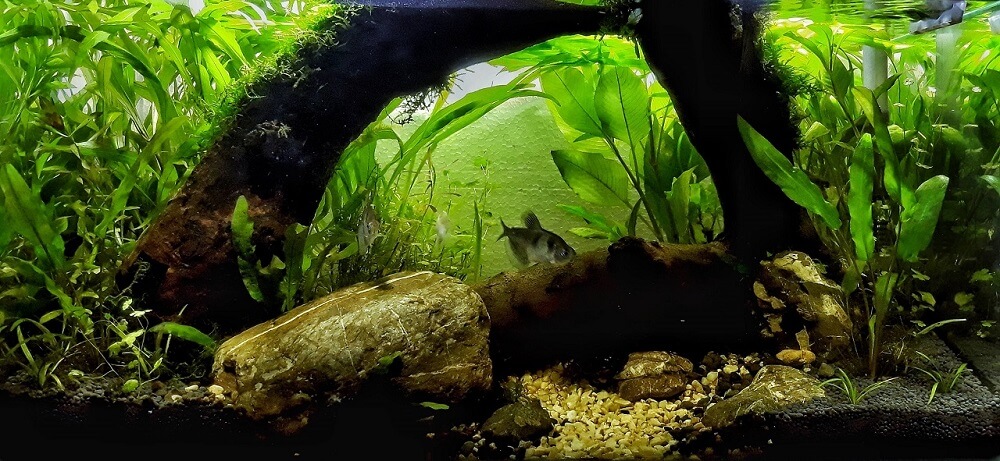








































































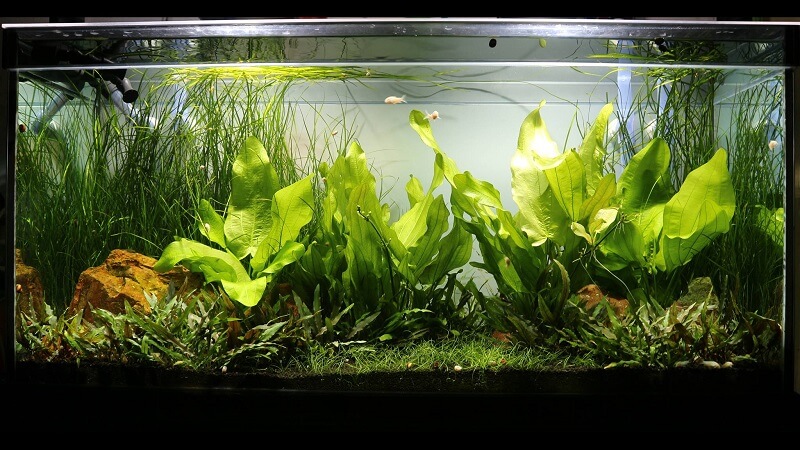
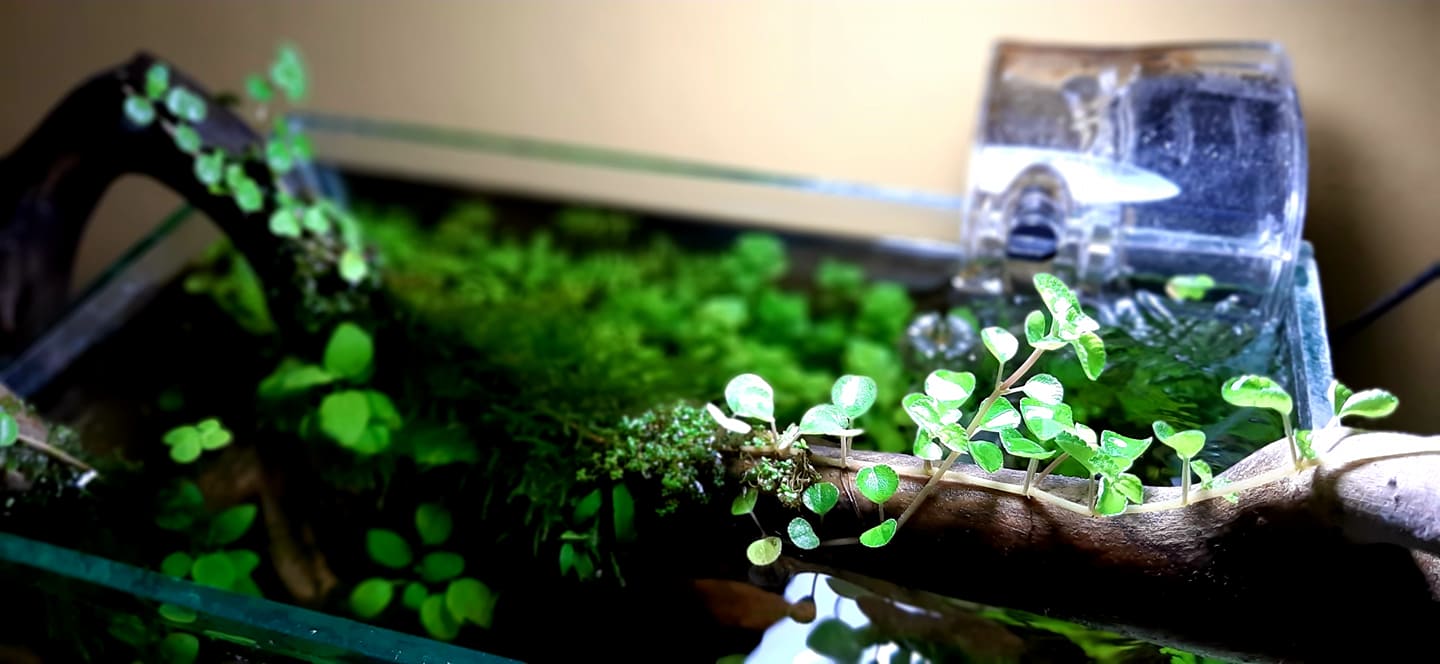



The jungle style is quite popular when it comes to aquariums but the main problem is that some people don’t do it right or maybe they just do it differently. I’m happy to see you share this post on how to do the jungle style aqua designs. You also added the type of tank and fish to use in this design. Great work!
Thank you Riley that you find my article informative and I hope in some way or two, I was able to help you decide to start your very own planted aquarium at home. Please watch out for more articles coming soon.
Aquascaping designs if well dine can really make a lot of difference and add the special feeling of love and coziness to the design. However, it has to be well done and gotten accurately. This guide here is really great to see and to be honest, I fi d this worthwhile. I love this jungle aquascaping design and if I can, I will try it out
Thank you Ella and I hope in some way or two, I was able to help you decide to start your very own little piece of nature at home. Please watch out for more articles coming soon.
Such a diverse article about aquascaping in jungle style! I never would have thought there to be so many different designs. Your article is quite thorough, it increased my respect for the aquascaping arts. Do you have to be experienced in botanics or marine biology to be able to try aquascaping?
Hi Johanna thank you that you find the articles about aquascaping styles diverse and informative. Quick answer is ‘no’ on your question. My only experience with plants is when helping my mother with her garden. Most beginners who started this hobby don’t even cared for any fish before. It is not really requirement but you are in the right direction by finding my site. Please watch out for more articles coming soon.
I really like the look of the jungle style aquarium. To me it looks more natural. You mention using fish that are proportionate to the size of the tank if using tank smaller than 30 gallons. I would probably want to start out with a smaller tank to start with. Do you recommend any particular type of fish for beginners? Also, do most fish live well in this type of jungle setting, or is it better for certain types of fish?
Hi Randy thanks for coming back! Yes smaller tanks like 10 to 15 gallons long are perfect for beginners as I explained in Tank Dimensions. Hardy nano fish examples are chili rasboras, cardinal tetras, ember tetras, neon tetras, bettas, harlequin rasboras, guppies, mollies, platties, danios, swordtails, white cloud mountain minnows, pygmy corydoras to name a few, etc. I didn’t mention neon tetras as they are more sensitive to your water parameters than cardinal tetras. Some Otocinclus species are also sensitive, but they can generally be put into a well established and stable tanks.
You can even pair these hardy fishes with neocaridina shrimps like red cherry shrimps, and snails like nerite snails…and yes they are perfect for most aquascaping styles……
Am a huge Fan of home decors and interiors, I have eventually turned my home into a Paradise with lots of decorations ranging from plants to animals down to inanimate objects, I eventually get anything nice looking to spice up my home but never had anything regarding aquascapes trust me I will definitely get one one these.
I will best go for a nice tank to put at the entrance of my sitting room to entice visitors with a gold fish that best brings out it beauty thanks to this lovely article for such a great idea
Hi Evans, thank you for sharing your experience. A planted aquarium will definitely spice up your home more. Please watch out for more articles coming soon.
This is really cool article
i love nature and i love the fact that you can have bring it through the acquarium to your home even to the bed room..lol, with all the tips, guideline and aquascape designs one can successfully set up an aquarium in his or her home, some people thinks that all plant requires CO2, thanks to this article many will be sure about the tank to use, the type of light to use, whether or not to use CO2 etc.. thanks again this is really helpful.
Hi Alexy thank you that you find my article informative. All plants even aquatic ones definitely need CO2, but a lot of aquatic plants are not too demanding on CO2. CO2 is produced in the aquarium naturally when fish respire, when beneficial bacteria breaks down fish wastes and organic dead matters (dead leaves), and even enters the aquarium by providing water surface agitation. We only deliberately inject CO2 if we put very demanding plants in our aquariums as the ones naturally produced in the aquarium is not enough. This will be thoroughly discussed on future articles coming soon so please watch out for that.
I actually found this article very helpful. This is one of the things I’m looking forward to do in the nearest future. Initially, I didn’t understand what Jungle style is completely all about but I now have a good knowledge about it.
I have equally understood that soil can be treated and also the kind of light to use and the kind of fishes involved in this. I’m pleased I learnt this. Thank you for such an informative article.
Thank you Kenechi that you find this article very helpful. If you have some questions, don’t be afraid to ask. We have your back! Also, please watch out for more articles coming soon.
This was a very well thought of and researched post. Before I read this, I knew nothing about jungle aquascaping. Very informative, from what tank to use to proper lighting, substrate and fertilizers, filtration and Co 2.This was just the tip of the iceberg in a very knowledgeable analysis. Well done!
Thank you Ronn and I hope in some way or two, I was able to help you decide to start your very own little piece of nature at home. Please watch out for more articles coming soon.
I find aquariums bring alot of peace. They bring tranquility to a space. When I scuba dived years ago, I had a new found appreciation for marine life. It was a beautiful experience. I think the larger the aquarium the better.
Hi Martine,
Thanks for sharing your experience with scuba diving and your new found appreciation for marine life. Please watch out for more articles coming soon.
I enjoyed this article about jungle style aquascapes, which I had never heard of before. I especially liked the little outline of the article at the top, which makes it easy for people to go the part of the article they are most interested in. Lots of great pictures too.
Hi Bryce thank you for the appreciation and your comment about the ease of navigation of my website. Please watch out for more articles coming soon.
Hi, very informative article especially for someone like me. Unfortunately, i have no previous experience with the aquariums. So I find this article very helpful. I heard a lot of people talking about Jungle Style aquariums, but now i have a clear picture of what they represent. I’m looking forward to reading more of your stuff.
Hi Srdjan,
Thank you so much that you find this article informative. You can start a planted aquarium even if you don’t have any experience at all. But it needs your commitment and motivation and new found love for this hobby certainly.
Please watch out for more articles coming soon. If you have more questions, please don’t hesitate to ask.